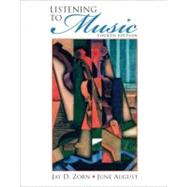
| The Musical Process | |
| From the Creator to the Listener | |
| How to Listen to Music | |
| Becoming a Musically Active Concertgoer | |
| The Materials of Music | |
| How the Basic Musical Elements Interact | |
| Performing Media: Instruments, Voices, and Ensembles | |
| The Common Style Periods of Concert Music | |
| An Introduction to Musical Styles | |
| Music Before 1600 | |
| The Baroque Style Period (1600-1750) | |
| Baroque Music (1600-1750) | |
| The Classical Style Period (1750-1820) | |
| Music of the Classical Period | |
| Beethoven: Bridge to Romanticism | |
| The Romantic Style Period (1820-1900) | |
| Early-Romantic Music | |
| Romantic Opera | |
| Late-Romantic Music | |
| Nationalism | |
| Impressionism | |
| The Twentieth-Century Style Period | |
| Stravinsky: Into the Twentieth Century | |
| Expressionism: Atonal Music | |
| Neoclassicism: Mainstream Music | |
| Experimental and Technological Music | |
| Development of Music in North America | |
| Adjunct Music | |
| North American Popular Music | |
| Broadway Musical Theater | |
| Music in the Movies | |
| Contributions of World Cultures | |
| Finale: Audience Power in the 21st Century | |
| Music Notation | |
| Common Scales in Music | |
| Writing Reports | |
| Music Listening Guide | |
| Challenge Your ExpertiseAnswers | |
| Glossary of Music Terms | |
| Photo Credits | |
| Index | |
| Table of Contents provided by Publisher. All Rights Reserved. |
The New copy of this book will include any supplemental materials advertised. Please check the title of the book to determine if it should include any access cards, study guides, lab manuals, CDs, etc.
The Used, Rental and eBook copies of this book are not guaranteed to include any supplemental materials. Typically, only the book itself is included. This is true even if the title states it includes any access cards, study guides, lab manuals, CDs, etc.